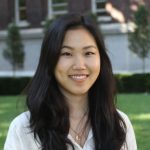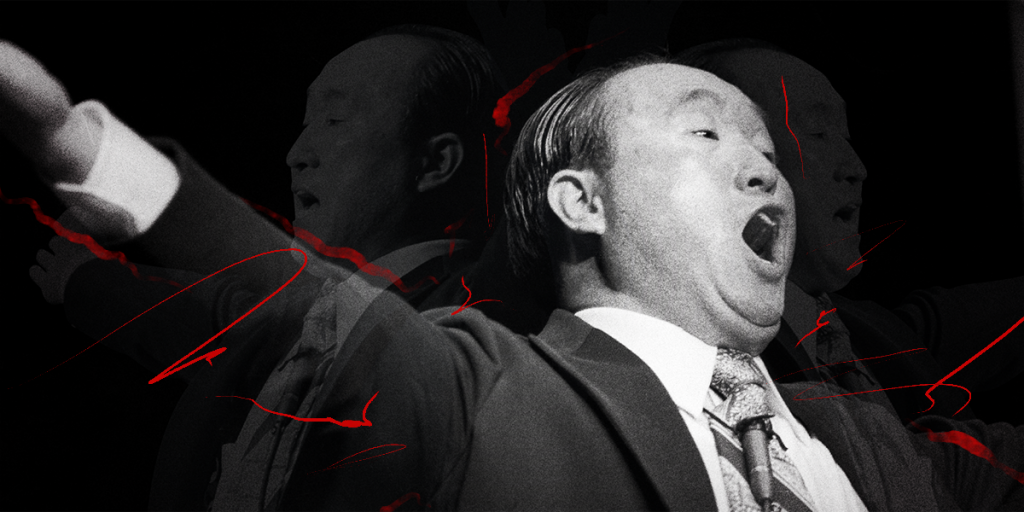- The Unification Church was founded by Rev. Sun Myung Moon in 1954.
- Many children born into the church grappled with its strict expectations.
- Ex-members talked to Insider about their experiences growing up in — and leaving — the controversial church.
This article is the first in a three-part series telling the stories of those who were born into the Unification Church, and their experiences trying to leave it.
"I will fight for God! I will fight till I die!"
Sujin* threw herself into the chant. It was the summer of 2012, and she and four other teens were on a three-month-long road trip — driving from Texas to Arizona, and then onto New Mexico, California, and Washington — to raise money for their church.
Sujin and her peers were members of the Family Federation for World Peace and Unification, more commonly called the Unification Church. Elders in the church, known in the 1970s by the pejorative "Moonies," told the teenagers they were on the frontlines, on a mission to become more attuned to their inner, spiritual selves.
The money they raised selling trinkets, of course, was just an added bonus for the church they had all belonged to since birth.
The Unification Church was founded in South Korea by Reverend Sun Myung Moon in 1954. It swiftly gained traction in Korea and abroad through the work of devoted missionaries, who believed in Moon's mission of unifying the world through peace and faith. The new religious movement reached its height in America in the 1970s, attracting followers from countries around the world and gaining notoriety for its Blessings, or mass arranged marriages. The Unification Church currently has 10 million members worldwide, according to a spokesperson of the church, and between 10,000 to 25,000 followers in the US, though some experts argue for much lower numbers.
On July 8, 2022, the church re-entered public consciousness after Japan's former prime minister Shinzo Abe was assassinated while speaking at a campaign event. Police and Japanese media have since suggested that his alleged attacker, Tetsuya Yamagami, was upset about Abe's ties to the Unification Church, which Yamagami's mother had been a member of, and which he claimed had driven her to debt.
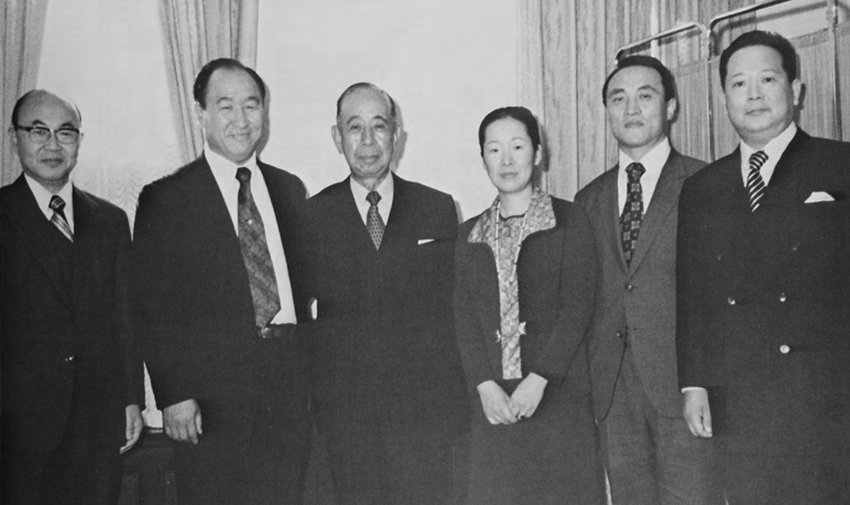
Despite the controversy that surrounds it, the church has long maintained associations with some prominent world leaders, including U.S. presidents Richard Nixon, Ronald Reagan, George H.W. Bush, and Donald Trump, who praised the church for "the inspiration that they have caused for the entire planet." The church's current leader, Tomohiro Tanaka, has said that Abe supported the church's peace movement, even if he himself was not a member. In 2021, Abe delivered a speech for an organization affiliated with the church.
Rev. Moon's widespread influence, and the wealth that accompanied it, has come under scrutiny by critics of the church, culminating in an FBI investigation in 2002. The more than 500 pages of documents from the FBI's file on Moon reveal allegations of bribery, slavery, and involuntary servitude, especially through the sale of "trinkets" and other donations. No charges were filed.
Raised to be 'sinless'
The Generation Peace Academy was a year-long program that most children born into the church — or, "second-gens," as they referred to themselves — like Sujin participated in before attending college. It was a rite of passage, a test of faith for the self-proclaimed messiah's younger followers. Sujin had already spent three months in New York proselytizing in Bryant Park and attending church-mandated lectures, which drilled into second-gens the importance of purity and of unwavering belief in Reverend Moon, their "True Father."
"Rev. Moon often pressured parents to raise their kids right, since Blessed Children" — another name for second-gens — "are meant to be sinless. There was this expectation of creating a new world with pure families," Sujin explained to Insider. This meant no alcohol, no smoking, and certainly no sex until marriage.
The second-gens were now in their final phase of the program: fundraising, primarily through the sale of trinkets. It was May 2012, on the cusp of one of the worst heat waves in American history. Most nights, Sujin and her fellow fundraisers slept on wooden boards set up at the back of their van, which they stationed at Walmart parking lots, washing their faces and armpits in public bathrooms.
Their days began at 7 a.m. and consisted of fundraising around town, with short breaks for fast food lunches and water. Sometimes, the girls would go "bar blitzing" in the evenings, which meant pairing up to sell trinkets at local bars. The church instituted this system of working in pairs after Jin Joo Byrne, an 18-year-old second-gen, was strangled to death during one of her fundraising runs in Charlotte, N.C., in 2002. Sujin remembered other members saying that church leaders had told them that it was a good thing Jin Joo was killed before she was raped. It was better to die, they said, than to be defiled.
The suncatchers the teenagers sold were bought in bulk from a supplier in the Philippines at less than $1 a piece. The teenagers were instructed to sell them at a considerable markup: A smaller one, priced at $15, had a pink flamingo on it, framed in green fronds of grass. The more expensive ones, sold at $35, had designs like blue- and brown-winged butterflies. On a good day, Sujin could rake in as much as $400.
"We made bank," Sujin said. "We were encouraged to get anything from anybody."
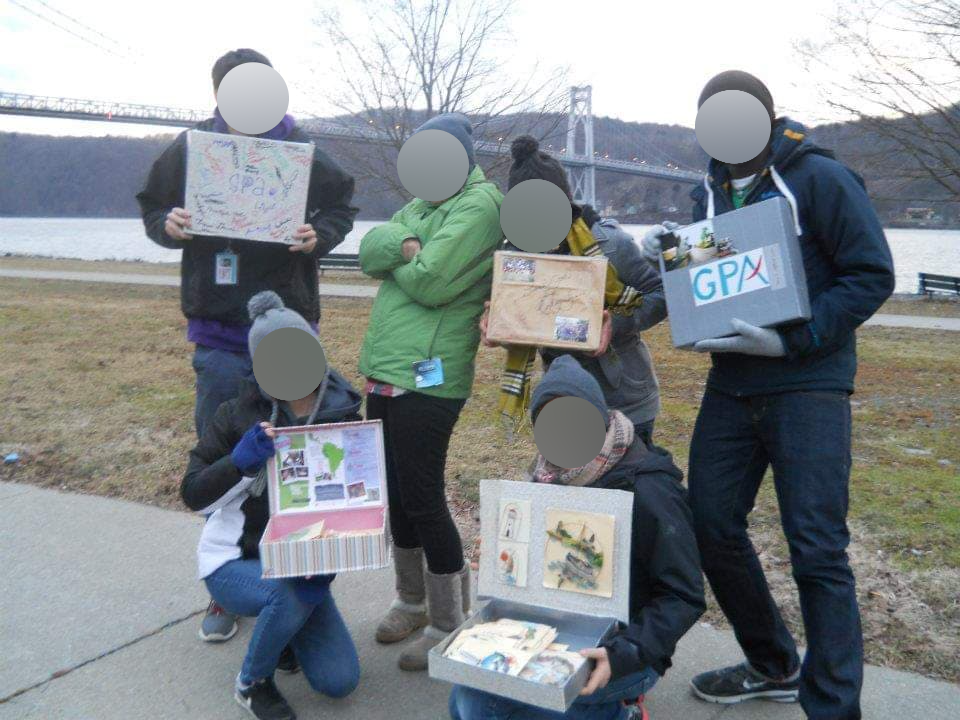
The cash they pooled together at the end of each day were "offerings" to God. A small portion of it was used for the team's food and gas, and the church said the rest was used for overseas trips for second-gens. But with around 120 fundraisers spread out across the country in different teams, each making around $400 on a good day, for three months, Sujin guessed that there was plenty of money going to the church itself.
It was widely known that the Unification Church owned hundreds of acres in upstate New York, including at least four sprawling estates with names like Gracemere and Belvedere. It also reportedly spent $1 billion — much of which came from its members' own pockets or fundraising efforts — to build the Cheongpyeong palace in Korea, which became the church's mecca.
But on her road trip, Sujin reminded herself of their central mission. It wasn't about the money; Rev. Moon said that the real purpose of these fundraising trips was to focus on your internal goals, which would bring you closer to God. Sujin mentally repeated hers: Give God's love. Be present. See God in others.
"You were a good member if you were the best follower," Sujin said. "A lot of times, that involved shame and guilt."
An offering to God
During one of her fundraising outings, Sujin spotted a tall, skinny man holding grocery bags, walking across the lot.
"Hi, how are you?" She always started with a simple opener, unassuming and harmless. She opened the lid of her box, showing the suncatchers, gleaming in the light. "I'm fundraising for my youth group, the Generation Peace Academy." They never said they were from the Unification Church, which had a reputation as a church filled with "brainwashed Moonies."
"The church had an 'us versus them' mentality," said Sujin, now 28. "Second-gens were always told that outsiders wouldn't understand us. They instilled a lot of fear, maybe on both sides."
What she wouldn't include in her pitch was that, by donating money and buying a suncatcher, they were buying themselves a spot in Heaven. It didn't matter if they didn't believe in God, or followed another religion. They were buying their salvation, even if they didn't know it.
"In my mind, I tried to tell myself, 'This is for God. If we take money from people, it's their offering to God, and they're buying themselves a spot in Heaven,'" Sujin said. "It was like secret witnessing."
The man, who Sujin guessed was in his forties, seemed nice enough, and asked her about her faith. When she mentioned the Bible, he grew animated, quoting verses from memory.
Sujin was taken aback. She couldn't quote anything from the Divine Principle, the core theology and written teachings of Father, as she and other church members called Rev. Moon. Wow, she thought. His faith is so much stronger than mine.
The man asked if he could pray for her, and, with eyes closed and head bent, asked God to help this young woman accept Jesus into her life and attain salvation. As Sujin walked away, clutching her box of suncatchers, she was shaken with a thought that scared her, one that was the first in a trail of questions that would eventually lead her away from the church she'd grown up in.
"How can these people, so dedicated to another religion, go to Hell," she asked herself, "if mine is the right one?"
From church to global business empire
According to the Divine Principle, the Unification Church's main theological textbook written by Moon and an early disciple, Moon was born on January 6, 1920 in a rural village in what is now North Korea. Raised in a Christian family, he was praying on a mountaintop one Easter morning when he was struck by a vision. Jesus appeared before him and asked him to accomplish the work he had failed to complete before his crucifixion: To purify the earth by producing sinless children. The 16-year-old accepted his mission, taking on the mantle of messiah.
Excommunicated from the Korean Presbyterian Church for heresy in 1947, Moon officially founded the Unification Church seven years later. He divorced his first wife, Sun Gil Choi, in 1953, after she couldn't accept his doctrine. Seven years after the divorce, he married Hak Ja Han, whom he deemed "the perfect woman." Together, they are called the "True Parents" of a purified world by their followers, and their biological children the "True Children."
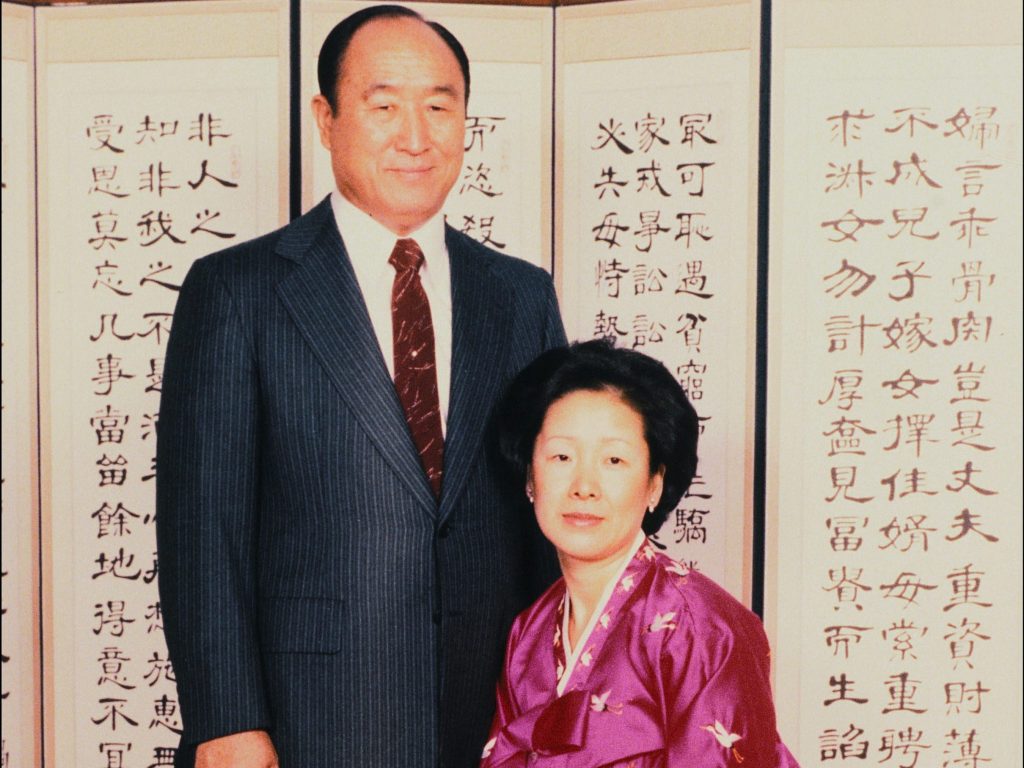
Over the next few decades, the Unification Church grew from a religious group to a transcontinental business empire, which included schools and universities, hospitals, ski resorts, dance academies, and a soccer team. The church owned "The Washington Times," a conservative newspaper in D.C. that President Reagan allegedly read every morning; the Manhattan Center, a large event space in New York City on 34th Street; and, right next to it, the New Yorker Hotel, which serves as the church's main office in Manhattan.
The church said that its multiple operations earned tens of millions of dollars a year, and, at one point or another, Rev. Moon and his family lived in one of the mansions the church owned, such as the 18-acre East Garden estate that had a ballroom, two dining rooms, and a bowling alley.
Most of this wealth was not part of the second-generation's daily lives, but reserved for Moon's family and his circle. Followers were drawn to the church not for wealth, but for a sense of community and the promise of salvation.
Matching marriages
Sujin's parents joined the Unification Church for different reasons. Her dad, a sturdy man who grew up with 11 siblings on a farm near São Paulo, joined the church because his own father was an avid follower. Sujin's mom joined when she was at college in the Philippines, drawn to the sense of community the church offered.
They met just a few days before they were married, in a packed hall in Korea. The men stood on one side, the women on the other. All it took to be matched was for Rev. Moon to point at one man, then at a woman.
The newly-matched couple shared their first, stilted conversation through Sujin's uncle, who translated between English and Portuguese. They were Blessed by Rev. Moon on January 12, 1989 in Korea — one of hundreds of couples to be matched and married by the reverend in a mass wedding ceremony.
Just like Sujin's parents, mixed-race weddings, or "Blessings" are the norm in the church, which seeks to unify people from around the world.
"Marriage creates a relationship between two families, and it brings reconciliation between clans and countries," Moon wrote in his autobiography. "When a Korean and Japanese marry, it contributes to reconciliation between the two countries; when a white person and a black person marry, it contributes to reconciliation between the two races."
A new beginning that 'transcends the races'
The parents of two other second-gens, Yuri* and Hana*, were also matched and Blessed at a mass wedding at New York's Madison Square Garden on July 1, 1982. Yuri's dad is American and his mom is Japanese, while Hana's dad is Japanese, her mom American.
"I think a lot of our parents — the first generation — joined for that community feeling," Hana said.
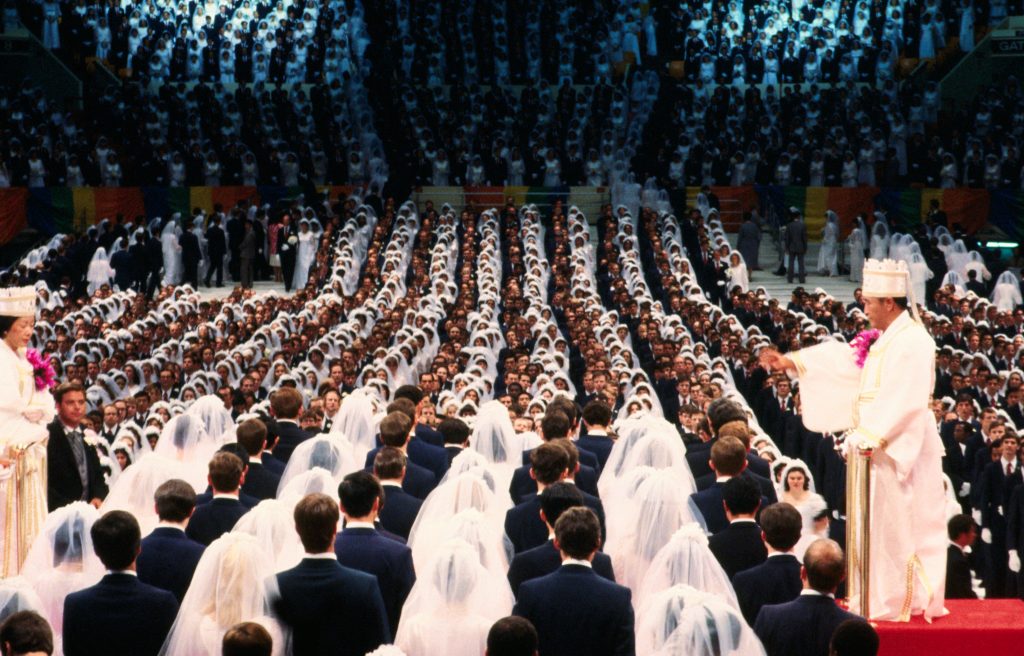
Just like Sujin, Yuri and Hana were Blessed Children — the progeny of these holy unions and were therefore born pure, untainted by the original sin that Adam and Eve had committed by being tempted by sex.
"The children of such marriages represent harmony because they inherit the lineage of two races. They represent a new beginning for humanity that transcends the races," Moon wrote.
While their parents had elected to become followers, second-gens hadn't chosen to join the church. They were born into it.
On Sundays, Hana's parents often woke them up at 4 a.m. to drive the family to Belvedere, a 35-acre mansion owned by the Moon family in Tarrytown, New York. Service usually lasted at least three or four hours, and Hana and her sister inevitably dozed off.
Yuri, who grew up in a large church community in Nutley, New Jersey — an otherwise mostly white, Italian neighborhood at the time — watched as his four older siblings dealt with blows from other kids in school, who teased them for "being the Asian kid, the Moonie." Parents didn't want their children hanging out with them, either.
"I knew there was a reason. Everyone knew you were the 'cult kid,'" Yuri told Insider.
Yuri watched as his siblings eventually got matched in their own Blessed marriages. But the church's dogma and stringent expectations of purity clashed with what some second-gens experienced firsthand in the "outside" world. This led many adolescent Blessed Children to question the doctrines they had grown up with.
"Second-gens were told we were special. We were guilted into being perfectionists," Sujin said. "We were just kids. Who doesn't want to feel special?"
As Sujin became increasingly aware of her own complicated sexuality — and of the church's hypocrisies — she would soon come to harbor doubts about the church she'd grown up in.
Sujin, Yuri, and Hana would all eventually make the difficult decision to leave the church, which also meant re-examining their relationships with family and with God, as well as with their own identities.
The Unification Church did not respond to requests for comment for this story.
*Names have been changed. Subjects spoke to Insider on the condition of confidentiality.
